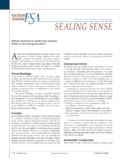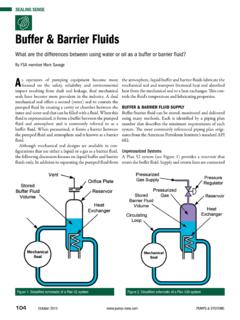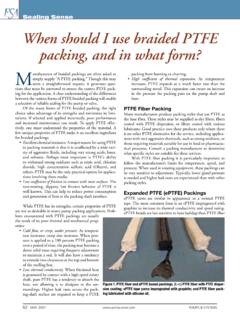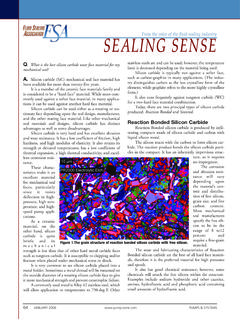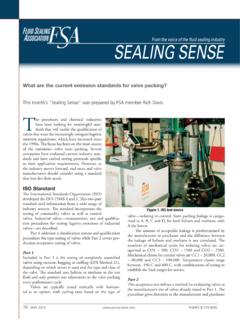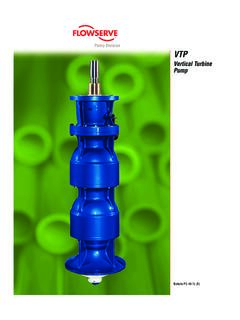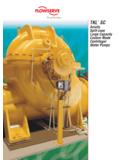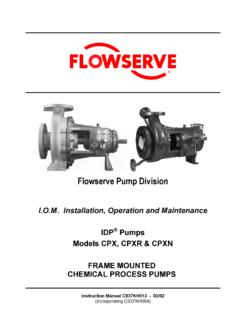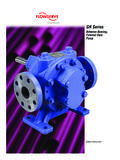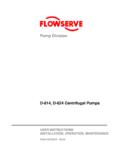Transcription of SEALING SENSE
1 114 OCTOBER 2007 pumps & SYSTEMSTwo imperatives for many of today s industrial plants are to reduce the cost of operations through the enhancement of rotating equip-ment reliability and enhanced energy effi ciency of pumping place to look for a signifi cant, yet relatively easy quick win, is the seal fl ush water going to pack-ing, single, and double seals. In many industrial plants water is being used to provide lubrication, cooling and/or as a means to exclude a harmful process fl uid from the stuffi ng box or seal means for providing an external water fl ush or quench are generally described as API/ISO piping plans 32 (ANSI 7332), 54 (ANSI 7354) or 62 (ANSI 7362). These plans have certain potential issues that can be opportunities for improving operating costs, namely:Higher fl ow rates than required for optimal pack- ing or seal fl ow rates than required for optimal pack- ing or seal ces plugging with no readily accessible means to clean and space consuming piping con- fi gurations in order to include basic requirements of an appropriate system, such as pressure and fl ow control as well as monitoring, check valve and low fl ow potential solution to address these issues would be a single compact unit that includes all of the func-tionalities below:Allows the end-user to readily optimize seal water pressure and fl ow to maximize packing and mechanical seal the end-user to readily monitor the seal water pressure and fl ow.
2 Conveniently and economically incorporates a low fl ow alarm while still maintaining a minimal piping space. Typically will reduce seal water consumption by about 1/3rd while optimizing packing and How can I reduce consumption of seal water going to my packing and mechanical seals? From the voice of the fl uid SEALING industry SEALING SENSEF igure 1. Diagrams of API Plans 32, 54 and 62 fl ush & SYSTEMS OCTOBER 2007 115mechanical seal performance. Reduces process dilution. Can enhance rotating equipment reliability by alerting plant personal to a low fl ow condition that could lead to an unplanned maintenance event. Easy to maintain with readily accessible cleaning button that does not disturb fl ow or pressure. Water quality is an important consideration. Plant water quality can vary signifi cantly from one location to another and affect these units, so it should be monitored. Inspection and maintenance procedures should take water quality into consid-eration.
3 It also is always best to consult with your seal supplier to ensure optimum cooling fl ow rates for your is an example of a way to achieve signifi cant operat-ing savings through optimizing seal water fl ush. The basis is reduction in seal water consumption by an average of 1-gpm per stuffi ng box served. The bottom line on how to reduce consumption of seal water going to packing and mechanical seals is to consider replacing your existing seal water fl ush piping plan with a single unit seal water fl ush control and monitoring device. You will save operating costs as well as Month: How do I troubleshoot compression packing?Fluid SEALING AssociationSealing SENSE is produced by the Fluid SEALING Association as part of our commitment to industry consensus techni-cal education for pump users, contractors, distributors, OEMs, and reps. This month s SEALING SENSE was prepared by FSA Member Tom Haan.
4 As a source of technical informa-tion on SEALING systems and devices, and in cooperation with the European SEALING Association, the FSA also supports development of harmonized standards in all areas of fl uid SEALING technology. The education is provided in the public interest to enable a balanced assessment of the most effective solutions to pump technology issues on rational Total Life Cycle Cost (LCC) Mechanical Seal Division of the FSA is one of fi ve with a specifi c product technology focus. As part of their educational mission they develop publications such as the Mechanical Seal Handbook, a primer intended to comple-ment the more detailed manufacturer s documents produced by the member companies. Joint FSA/ESA publications such as the Seal Forum, a series of case studies in pump per-formance, are another example as is the Life Cycle Cost Esti-mator, a web-based software tool for determination of pump seal total Life Cycle Costs.
5 More recently, the SEALING Systems Matter initiative has been launched. It is directed to sup-port of the case for choosing mechanical seals that optimize life cycle cost, safety, and environmental following members of the Mechanical Seal Divi-sion sponsor this SEALING SENSE series:Advanced SEALING International (ASI)Ashbridge & Roseburgh Chesterton America, Performance Elastomers LLCE agleBurgmann Industries LLPFlex-A-Seal, Flow Solutions Div. - Seal GroupGarlock SEALING TechnologiesGreene, Tweed & , Vago de Mexico SA de CVJohn CraneKC AmericaLatty International Carbon AM&TParker Hannifi n Seal GroupPPC Mechanical SealsSEPCO - SEALING Equipment Products Co., - Div. of Freudenberg-NOK SGL Technic Polycarbon DivisionFigure 2. Typical Compact Flush Water MonitorNumber of stuffing boxes 100 Estimated current average seal water flow per stuffing box 3-gpm Average reduction in seal water consumption per stuffing box 1-gpm Current seal water consumption 157, 680,000-gallons /year Seal water consumption optimized resulting in 33 percent reduction 52,034,400-gallons/year Savings in water consumption 47,304,000-gallons/year Cost of water per 1,000 gallons* $ Savings per year $46,830** * Based on blended cost of water and sewer for industrial users in a Midwestern City with 20 percent of seal water flow going to sewer.
6 ** In addition to these savings, the end-user may realize additional benefits from reduced process dilution and with the low flow alarm, potentially saving an unplanned maintenance event.
